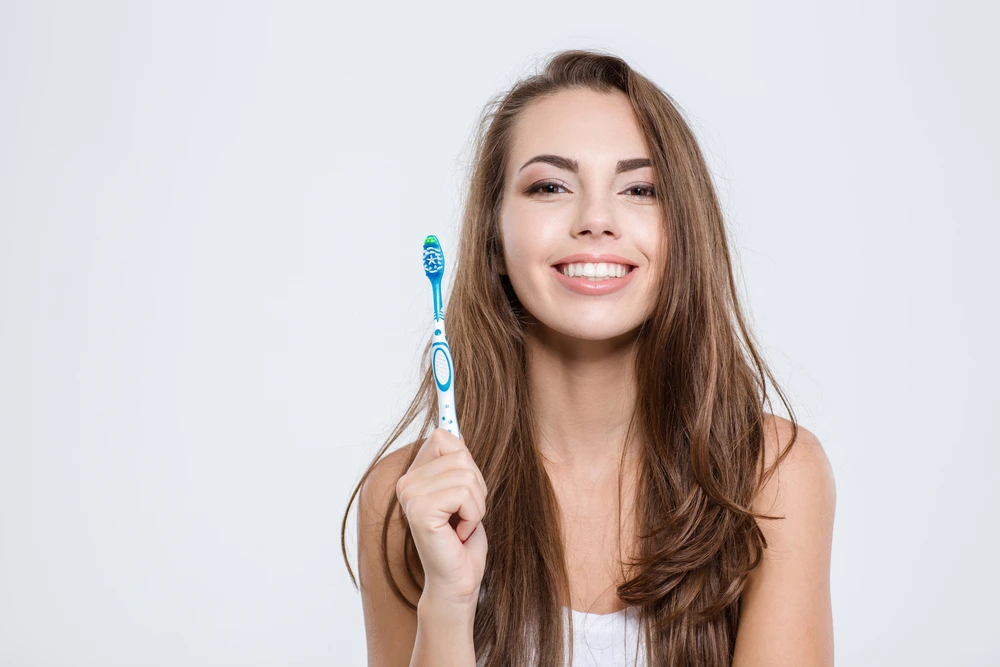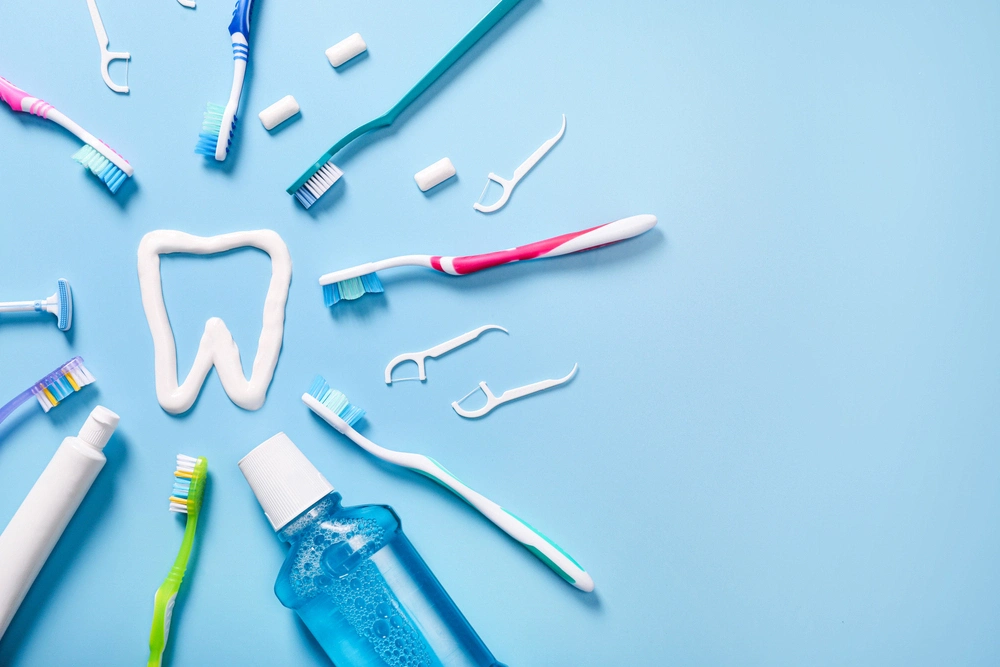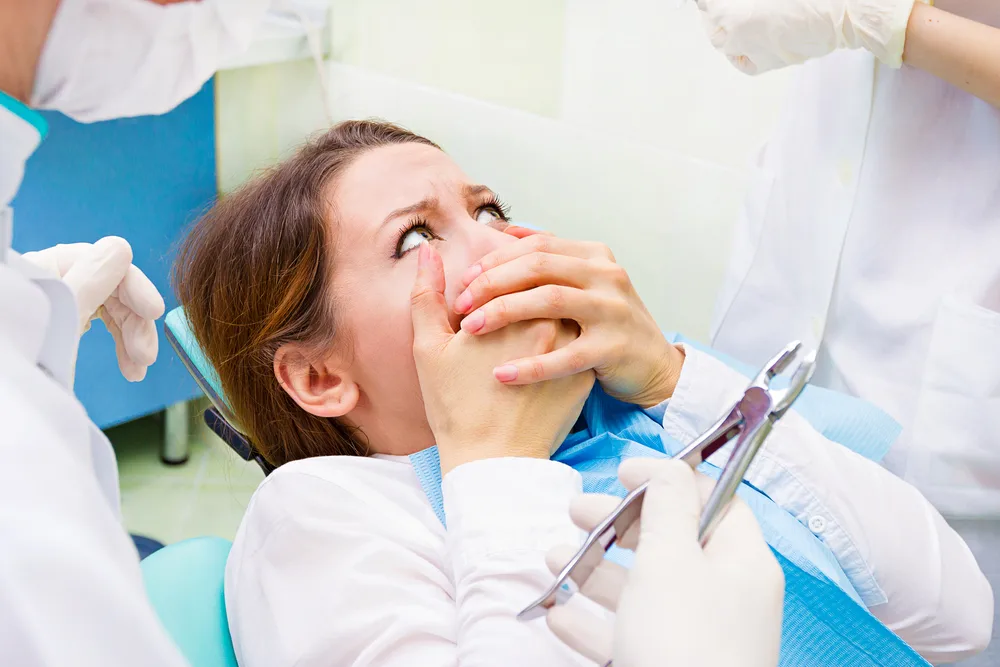




If knowing that bacteria and fungus accumulates on your toothbrush bristles overtime isn’t enough reason to replace your toothbrush more often, there are also a number of other risks and uninviting issues involved with not replacing your toothbrush. One risk includes damaging your gums, as old toothbrushes become ineffective with removing plaque from your teeth, which leads to gingivitis. Left untreated, gingivitis leads to infection, which can cause teeth to fall out.
Even more unappealing, you can get sick from overused toothbrushes (see: bacteria and fungus build up), your toothbrush can grow mold, or possibly the least appealing, you can ingest unwanted particles if stored near a toilet.
I don’t know about you, but I’m going to go change my toothbrush right now and schedule a deep cleaning with my dentist.

Ask your dentist during your next dental checkup and cleaning for recommendations about what you should be buying based off your individual needs, your particular dental health state, etc.
Some common suggestions among dental professionals are to look for toothbrushes with soft bristles, as hard bristles damage your teeth and gums, choose a toothbrush head size that touches one or two teeth at a time, use a toothpaste containing fluoride approved by the ADA, consider using mouthwash to further fight plaque and gingivitis, and don’t forget floss!
Consider investing in an electric toothbrush, as these have been proven to improve oral health beyond what a manual toothbrush can do by removing plaque, reducing gingivitis and eliminating teeth staining. They’ve also been shown to minimize the amount of plaque on the teeth of people with periodontal disease.
Do your research on what products fit your needs best, and don’t forget to ask your dentist for recommendations.
Dentistry is the diagnosis, treatment, and prevention of conditions, disorders, and diseases of the teeth, gums, mouth, and jaw. Often considered necessary for complete oral health, dentistry can have an impact on the health of your entire body.
A dentist is a doctor who works to diagnose, treat, and prevent oral health problems. A dentist usually has a 4-year degree from a college or university and subsequently completed an additional 4 years of dental school to receive a DDS (Doctor of Dental Surgery) degree. Dr. Ness is a general dentist with 8 years of education beyond high school. There are specialty degrees in the dental field, some of which are listed below, that require several more years of additional training. Dental specializations include:
Visiting the dentist regularly will not only help keep your teeth and mouth healthy, but will also help keep the rest of your body healthy. Dental care is important because it:
Your teeth may feel fine, but it’s still important to see the dentist regularly because problems can exist without you knowing. Your smile’s appearance is important, and your dentist can help keep your smile healthy and looking beautiful. With so many advances in dentistry, you no longer have to settle for stained, chipped, missing, or misshapen teeth. Today’s dentists offer many treatment choices that can help you smile with confidence, including:
Choosing a dentist who “clicks” with you and your family is important, and you may wish to consider several dentists before making your final decision. During your first visit, you should be able to determine whether the dentist is right for you. During your appointment, consider the following:
Dr. Ness’s personal treatment philosophy is very simple. Every patient in the chair is family. That individual will be presented options and cared for in a manner identical to what his sons, mother, staff etc. would be provided 100% of the time. Education is key, unless a patient is well informed they may not understand how a decision will impact them in the future. We care greatly that our patients are knowledgable and able to decide what is best for them because we took the time to assist him in their decision making process.
The American Academy of Pediatric Dentistry (AAPD) recommends that children first see a dentist as early as six months of age and no later than one year of age. During this time, your child’s baby teeth will be coming in and your dentist can examine the health of your child’s first few teeth. After the first visit, be sure to schedule regular checkups every six months. Please see more detailed comments on this in the pediatric section.
Children, teens, and adults should all see the dentist for a regular checkup at least once every six months. Patients who are at a greater risk for oral cancer or gum disease may be required to see the dentist more than just twice a year. Your doctor will help determine how often you should visit the dentist for regular checkups.
A cavity is a small hole that forms inside the tooth because of tooth decay. Cavities are formed when plaque buildup on the outside of the tooth combines with sugars and starches in the food you eat. This produces an acid that can eat away the enamel on your tooth. If a cavity is left untreated, it can lead to more serious oral health problems. Cavities can be prevented by remembering to brush your teeth at least two times a day and floss between teeth at least once.
A filling is a synthetic material that your dentist uses to fill a cavity after all of the tooth decay has been removed. Fillings do not generally hurt because your dentist will numb your mouth with an anesthetic. Fillings are made from a variety of different materials, including composites, gold, or ceramic. If you need a filling, be sure to talk to your doctor about what type is best for you and your teeth.
According to your dentist and the American Dental Association, you should brush your teeth at least two times a day. Brushing keeps your teeth, gums, and mouth clean and healthy by removing bacteria-causing plaque. It is also recommended that you use a soft-bristled toothbrush and toothpaste that contains fluoride when you brush your teeth. You should spend at least a minute on the top teeth and a minute on the bottom teeth, and remember to brush your tongue; it will help keep your breath smelling fresh!
Your toothbrush will eventually wear out, especially if you are brushing your teeth twice a day for two to three minutes each time. Your dentist recommends that adults and children change their toothbrush every three months. If you are using an electric toothbrush, be sure to read the directions because you may not need to change toothbrush heads as frequently. Patients with gum disease are encouraged to change their toothbrush every four to six weeks to keep any bacteria from spreading. After brushing, rinse your toothbrush with hot water to kill germs and keep the bristles clean.
Yes! In fact, it’s even more important that patients receiving orthodontic treatment visit their dentist regularly. With braces, food may be caught in places that your toothbrush can’t reach. This causes bacteria to build up and can lead to cavities, gingivitis, and gum disease. Your dentist will work closely with your orthodontist to make sure that your teeth stay clean and healthy while wearing braces. Some patients in braces may need to see their dentist every 3 months for cleanings.
Also known as periodontal disease, gum disease is mostly caused by plaque and bacteria buildup that is not treated in its early stage. Other causes of periodontal disease include tobacco use, teeth grinding, some medications, and genetics. Gingivitis is the beginning stage of gum disease, and, if detected, is treatable and reversible. Gingivitis left untreated may turn into more advanced periodontal disease that will lead to bone loss, and this is a permanent condition. Brushing your teeth regularly and visiting the dentist every six months will help prevent gingivitis and more severe cases of periodontal disease. Common signs of gum disease:
Yes! In fact, it’s even more important that patients receiving orthodontic treatment visit their dentist regularly. With braces, food may be caught in places that your toothbrush can’t reach. This causes bacteria to build up and can lead to cavities, gingivitis, and gum disease. Your dentist will work closely with your orthodontist to make sure that your teeth stay clean and healthy while wearing braces. Some patients in braces may need to see their dentist every 3 months for cleanings.
Simply call our practice! Our front desk staff will be happy to help schedule your next dental checkup at your convenience. If you are a new patient, please let us know and we will provide you with all the information you need for your first dental visit.

Infection control procedures are actions taken in health care settings to prevent the spread of disease. The Centers for Disease Control and Prevention has recommendations for dental office infection control. Your dentist cares about your safety and works hard to prevent the spread of infection. Before you enter the examining room, all surfaces, such as the dental chair, dental light, drawer handles and countertops, have been cleaned and disinfected. Offices may cover some equipment with protective covers, which are replaced after each patient.
Non-disposable items like the dental tools are cleaned and sterilized between patients. Disposable dental tools and needles are never reused. Infection control precautions also require all dental staff involved in patient care to use appropriate protective equipment such as gloves, masks, gowns and eyewear when needed. After each patient, disposable gloves and masks are thrown away. Before seeing the next patient, everyone on the treatment team washes their hands and puts on a new pair of gloves.
Your well-being is important to your dentist and dental staff. That’s why infection control procedures are in place at your dental office.

The ADA is the professional association of dentists dedicated to serving both the public and the profession of dentistry. The ADA promotes the public’s health through the commitment of member dentists to provide quality oral health care, accessible to everyone. The ADA promotes the profession of dentistry by enhancing the integrity and ethics of the profession, strengthening the patient/dentist relationship and making membership the foundation of successful practice. The ADA fulfills its public and professional mission by providing services and through its initiatives in education, research, advocacy and the development of standards.”
The ADA was founded in August 1859, at Niagara Falls, N.Y., by 26 dentists representing various dental societies in the United States. The ADA today has more than 141,000 members. It is “the largest and oldest national dental association in the world.”
The Association’s official publication is The Journal of the American Dental Association. Other publications include the ADA News and the Index to Dental Literature.
The ADA’s Council on Dental Education/Commission on Dental Accreditation is the nationally recognized accrediting agency for 1,242 dental educational and dental auxiliary educational programs in the United States.
The ADA library is one of the largest dental libraries in the world, with approximately 33,000 books, 17,500 bound journal volumes, and subscriptions to more than 800 journals.
The ADA formally recognizes eight specialty areas of dental practice: dental public health, endodontics, oral pathology, oral and maxillofacial surgery, orthodontics, pediatric dentistry, periodontics and prosthodontics.
This information is condensed from the ADA site (www.ada.org).